Archive for ‘General’ Category
Ruminations on Readers: Bibliophiles, Bibliomaniacs and You
A truly good book teaches me better than to read it. I must soon lay it down, and commence living on its hint. What I began by reading, I must finish by acting.
~ Henry David Thoreau
George Carlin famously asked “Have you ever noticed that anyone driving slower than you is an idiot, and anyone driving faster than you is a maniac?” Carlin’s own little theory of relativity has been on my mind this past week, not because of the disparate personalities on the road, but because of the divergent personalities of the book people.

There are all sorts of “book people” out there, and as a professional organizer and student of life, I’ve seen examples of many. I’m still awed by a decades-ago visit to Mark Twain’s house in Hartford, and particularly his floor-to-ceiling library. Not yet an organizer, I nonetheless found the idea of a room entirely dedicated to reading, with adequate shelving to (safely) hold a growing collection, sliding ladders, cozy lighting and comfortable seating to be an ideal. Every book had a home and could be accessed easily, and in both Twain’s time and my own, a staff was available to keep the books free from dust, grime, mold and any other dangers to literature, history and knowledge. One quick tour around the library made me feel that I knew the man, or at least knew the value he placed on reading, which is sometimes almost the same.
But I’ve also worked with clients so deeply tied to the idea of possessing certain books (as opposed to reading them) that nothing in my professional organizer’s arsenal could dissuade them. Some clients point vaguely to humidity-wilted, tilting towers of cobwebby, nibbled cardboard boxes, assuring me that all the books within them are essential and can never be purged. That they may not have been touched, let alone read or cared for, in decades, is a subject some are unwilling to entertain.
There have been numerous others who refused to “set free” books that were so water-stained and covered with mold that it was hard to make out the text, or who thought an adequate compromise involved taking a scissors to the margins of the books to cut away the “worst” of the mold, as if inhaling slightly fewer spores might be satisfactory. We are not talking about first editions; some of these books were acquired as bargain books and could easily have been repurchased for less than the cost of a cappuccino.

And recall the classic Twilight Zone episode Time Enough At Last, in which Burgess Meredith delivers his tortured portrayal of Henry Bemis, the last man on Earth, who finally has a lifetime to read and an almost endless supply of books…who accidentally breaks his glasses. No bibliophile can watch that and not feel anguish.
Book people feel fiercely about their books.

Film critic Roger Ebert’s blog post last week really struck a chord with readers, including Paper Doll. Reader comments are still growing a week after the post appeared, and his fascinating Books Do Furnish a Life post is gripping reading. Indeed, before we turn a metaphorical page, please go read his post…and even a smattering of the hundreds and hundreds of passionate reader comments…and then come back here. It’s OK, I’ll wait patiently. (I’ve got some books I can read in the meantime.)
Ebert is, at times, a great writer. He is also a great reader, and is not unaware of the complexities and difficulties his passion for books can cause. (Perhaps ironically, given the context of collecting vs. hoarding or even over-collecting of books, it’s on-point to note that Ebert’s post title is a riff on Anthony Powell’s Books Do Furnish a Room, the tenth in a twelve (!) book novel series, A Dance to the Music of Time.)
The professional organizer in Paper Doll battled her own inner bibliophile in reading Ebert’s post. Certainly, I could imagine discouraging him from keeping the inkless pens in the broken mug or the Tandy 100, capable of holding no more than 100 KB of data! And I would discourage the keeping of second (and third and fourth) copies of books (except for “reading” duplicates of valuable first editions, which one would wish to keep pristine).
However, as much as I love my career as a professional organizer and strive to help my clients trade chaos and dysfunction for serenity and a functional household or workspace, I understand the distress one faces when having to let go of books just because there is not adequate space for storage. (Of course, space is always the material issue. When one has sufficient space to store books, there is never any discussion of whether there will be sufficient time to ever read them.) It takes vigilance to keep the books from outpacing the space set aside for them, and it takes forbearance to purge the books that you love not for the writing, but for the memories associated with them.
There is the logical…and then there is the book lover.
Ebert’s post was only one inspiration for today’s Paper Doll ruminations. A few days earlier, I heard a fascinating Bob Edwards Weekend radio interview (click for the podcast) with journalist Allison Hoover-Bartlett, author of The Man Who Loved Books Too Much: The True Story of a Thief, a Detective and a World of Literary Obsession.

Hoover-Barlett’s book investigates the seamier side of rare book collecting, including an in-depth profile of John Charles Gilkey, who posed as a book dealer but who was, in fact, a thief who stole from rare book dealers and collectors.
The author’s depiction of how “book detectives” and the literary community came together to catch Gilkey sounds almost like a spy thriller. That the brazen thief Gilkey responded to Hoover-Bartlett’s inquiry as to whether he’d ever taken a book from a library with an appalled “No! That would be stealing!” just adds another bit of anecdotal evidence that books can make us a little…kooky…and no book lover is entirely immune.
Of course, an occasionally overzealous affection for books that might surpass available storage space does not necessarily eliminate one from the ranks of advisors. In the past two years, I’ve been confident in the advice I’ve imparted on personal libraries, from the practical, including:
Book ’em, Danno! Organizing Your Beloved Books
Shhhhh….We’re Organizing the Library
to the goofy:
No Fooling–Fabulous, if Not Functional, Ways To Organize Your Books
Be a Fool (for Organizing Your Books) Extravaganza
The continuum on which book-collectors, book-lovers and book-hoarders exist is hard to dissect or analyze; there are those who can sell or donate books they were given but not those they selected themselves (or vice versa), those who can let go of recent acquisitions but not those they’ve possessed for decades (even if they’ve never read them) and there are those who steadfastly hold on to every book because of a sense of the literary version of potential energy each title seemingly possesses.
Certainly, at the deep (and scary) end of the spectrum, there’s book hoarding, and though Paper Doll does not specialize in hoarding, I can share with you some behavioral and philosophical differences between collecting and hoarding.
- Collectors experience a sense of pride in ownership; that pride is evinced by creating a system for displaying the possessions in the collection. (Mark Twain and those who maintain his library come immediately to mind.) The system need not be “perfect”, but it enables bibliophiles to share their love of their possessions with others by showing off what they’ve collected…in some manner. As I often tell clients, “Don’t put things down; put them away.” Away is a concept which requires that any item in a collection has a home, where it belongs, and where it can be lovingly displayed. It is a heartbreaking truth for book-lovers to accept that there is a limit to how many books they can own. Professional organizers can help with creative solutions, but if you live in a phone booth, you just can’t keep your grand piano.
- Bibliomaniacs, or book hoarders, will likely have no system; instead, vertical, horizontal and upside-down piles of books, arranged without thought of author, category or inherent value, will appear on every flat surface. In extreme cases, bathtubs, beds and ovens will serve as storage. Book hoarders may speak of their “collections” lovingly, but the lack of loving treatment of, or organizing system for, the items may be reflected by embarrassment (an unwillingness to show or share the so-called collection) and an inability to find (or even actually know) what is owned, leading to repeated purchases of the same titles.
Not everyone has a passion for books. In NPR book critic Maureen Corrigan’s book Leave Me Alone, I’m Reading: Finding and Losing Myself in Books, she recalls Mr. (Josiah) Bounderby of Charles Dickens’ Hard Times, who sees books only as commodities. Corrigan says of these “Bounderbys” in modern life, “Books just don’t register with this crowd. They think I lack common sense; I think they lack a part of their souls.”
Nonetheless, I think many more of us than one might assume harbor a belief in the power of books. As Elie Wiesel said, “I feel that books, just like people, have a destiny. Some invite sorry, others joy, others both.”
Unlike most of my posts, this one does not seek to provide how-to instructions. (For that, read or reread the older posts linked, above.) Instead, this is a reflection on what books mean to us each, individually, and how our treatment of our personal libraries may reflect more about us than the titles within them. I’d love to hear what Paper Doll readers have to say about books–as their passions and their possessions–and how they are able (or not) to balance the lack of space to house them and time to read them with the yearning to possess the knowledge or concepts within.
- Are there books you are simply unable to set free, even though you know in your heart you will never read them again (or even once)?
- Do you own books on subjects that hold no appeal for you?
- Do you buy/acquire books even when your To Read pile has become a To Read room?
- Is it enough for you to just read a book without owning it? Or can/do you take advantage of your public library, BookMooch
 or PaperBackSwap
or PaperBackSwap 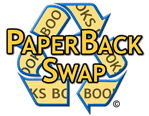 to read some books without adding them to your permanent collection?
to read some books without adding them to your permanent collection? - What would “enough” books look like to you?
Finally, one last book quote upon which we can ruminate, on a crisp autumn day:
The buying of more books than one can possibly read is the soul’s way of trying to achieve infinity.
~Author Unknown (Seen on a poster in a San Francisco bookstore)
Happy 2nd Anniversary, Paper Doll Readers
Last year, we celebrated the first anniversary of the Paper Doll blog with the traditional first anniversary gift of–no surprise–paper. This year, flummoxed by how to observe the blog’s second anniversary and shoehorn in paper when the traditional gift is cotton, I was excited to learn that paper is the traditional second anniversary gift in the United Kingdom. So, please imagine any text in this week’s post being spoken with an English (or Irish or Scottish or Welsh) accent of your choosing:





Too often in this blog, paper gets the bum’s rush. In recognizing that the influx of paper causes you readers anxieties related to finances, taxes, and even guilt associated with sentimental paper obligations, Paper Doll finds you digital alternatives so you can avoid paper and numerous workaround solutions to avoid the obstacles papers can place in your way. This summer, we revisited the top ten categories of past posts on how to break free from paper clutter.
Given all this, perhaps we spend too little time talking about the joy that paper can bring into our lives. In 2008’s Valentine to Paper, I spoke of how the affection a reader holds for the tangible experience of snuggling up with a good book will never be replaced by the efficiency of the Kindle. No USB-supported digital picture frame will ever be so lovingly protected as the photos received by World War II G.I.s, far from home, with only a snapshot of their best gals to keep them warm. And I assure you, no doting mother will ever believe there’s an alternative to seeing a paper diploma (framed and under glass that’s lovingly-polished daily). For some things, there are no substitutes for paper.
So, once again, in celebration and observation of another cycle around the Sun, I’d like to share just a few of the non-practical, non-essential delights in the world of paper.
It’s hard to fathom how he does it, but German paper artist Simon Schubert created this spectral hallway reflection below (see the ghostie?) with mirrored depths…by folding a piece of plain white copy paper.

Unless you read German, navigating these architectural design masterpieces, Escher-esque interior staircases and the other masterworks on this site can be a bit difficult. Instead, visit Schubert’s site’s PapierArbeiten section and just click on every darn one of the amazing 48 pieces he achieved solely by folding. (Don’t forget to pick your jaw up off the floor.)
We move from the spectral to the versatile to view the neato-keen paper sculptures of English artist Clive Stevens. The vibrant artistry of Stevens’ galleries can range from colorful three-dimensional charmers like this quaint Gamekeeper’s Cottage
 to an Explorer series of white-on-white depictions of the voyages of adventurers Roald Amudsen, Cheng Ho (Zheng He), Magellan, Erik the Red, Ibn Battuta and (below) James Cook:
to an Explorer series of white-on-white depictions of the voyages of adventurers Roald Amudsen, Cheng Ho (Zheng He), Magellan, Erik the Red, Ibn Battuta and (below) James Cook:
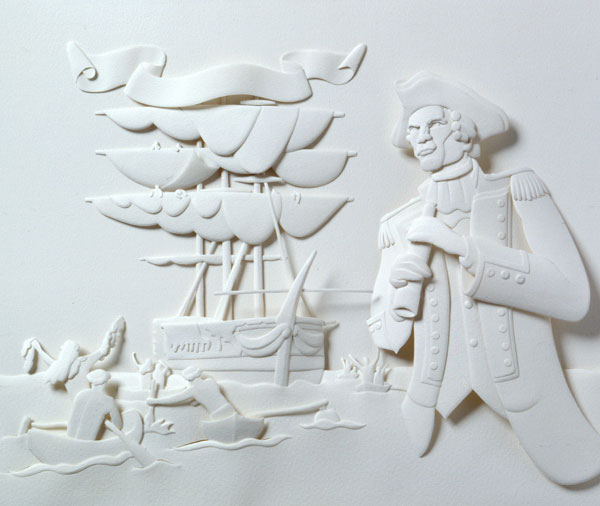
If you’ve got a desire to mix your inner Imelda with a love of whimsical paper, be sure to check out Puerto Rican artist/designer Carlos N. Molina‘s origami paper shoes (which I found through the fabulously quirky Lushlee blog):

Of course, not all paper that enchants us is tucked away in art galleries or designer boutiques. As this flickr find from the collection of David Ngo indicates, sometimes, just a piece of paper in the right place at the right time (a bulletin board, a blank wall, a telephone pole, etc.) is all we need to turn that frown upside down:

The fine print reads: “can be used to write down a phone number or email, place your gum in [sic], make mini footballs, write secret messages or just supplement your daily fiber intake”. (Don’t think it’s that cute? Try reading it in a British accent.)
In parting, I encourage you to spend at least a few moments today thinking about the paper in your life that uplifts you–a love letter saved from long-gone college days, a get-well card written in crayon, with some of the letters missing or carried to the next line, and even the mortgage paperwork that reminds you there’s a reason why you got up and went to work today. We’ll be back in the land of the practical next week; until then, join with Paper Doll and love thy paper.
Happy anniversary, Paper Doll readers, and thank you for your comments, queries and suggestions. Here’s to a great third year!
Paper Cuts: Don’t Let Hospital Billing Errors Bleed You Dry
Last week, Paper Doll took a week off from writing to recover from a minor medical procedure…let’s just call it a paper cut. All is well, and I’m happy to be writing again, and the topic on my mind is hospital billing.
A few months back, we talked about organizing your medical paperwork in order to be better prepared for emergencies and other health-related issues:
- Vital Signs: Organizing For A Medical Emergency, Part 1
- Vital Signs: Gathering Information During/After A Medical Emergency–Part 2
- Vital Signs: Maintaining Your Family’s Medical Records–Part 1 (Paper)
- Vital Signs: Maintaining Your Family’s Medical Records–Part 2 (Digital)
Keeping your family’s medical records organized is an essential part of maintaining their physical health, but don’t forget about the importance of financial health.
Harvard University research indicates that approximately 62% of U.S. personal bankruptcies are caused by unaffordable medical bills. Given that, it’s vital to keep track of medical billing, particularly hospital billing, to make sure you are being charged a fair and accurate amount. In fact, some medical billing experts believe that up to 80% of all hospital and medical bills contain at least one error, underlining the importance of vigilance in scrutinizing your medical billing paperwork.
So, what kinds of errors should you watch for?
Double-charging: Duplicate billing is a common hospital billing error. When you review your itemized bill, check dates and codes carefully to make sure you haven’t been charged twice (or more) for the same service, medication, procedure or supplies.
Where and When: Common mistakes on medical bills include mis-charging for room types (i.e., billing for a private room when when you shared a semi-private room, or billing for an ICU bed when you were given a regular private room) and mis-charging for dates of hospitalization. Check your bill to make sure you haven’t been charged for dates after your release.
Bills for tests or procedures never done: A doctor might order but later cancel a procedure. Months ago, Paper Doll found herself facing an MRI. Although I’d never actually teased anyone for having been too claustrophobic to undergo an MRI, I’d watched the test on numerous nighttime dramas over the years and been secretly flummoxed by how anyone could be so freaked out when there was SO MUCH SPACE. Then, I found myself face to face (or shall I say, nose to ceiling) with an MRI and lasted all of 6 seconds before screaming to be released. In some cases, after all the effort is made to prepare for and start a procedure, nobody notes a change in the record indicating that the patient was a complete scaredy-cat and the procedure eventually canceled.
In other incidences, services aren’t canceled so much as never rendered. Physicians may order a treatment or test that becomes unnecessary, but no notation makes it into the record to say that the work wasn’t done, leading to inaccurate billing.
Obvious, ridiculous errors: If your husband’s medical bill includes obstetrics-related charges, your first thought shouldn’t be that he’s been hiding a really big secret from you. The likely culprit? A simply typo or keystroke error by a data-input technician. One missed or transposed digit can be the difference between a bill for hundreds of dollars and hundreds of thousands of dollars.
Operating With a Bum Ticker (a bad clock, that is): If your hospital bill includes operating room time, check it closely to make sure you haven’t been billed for longer than your procedure took place. There’s no need to nickel-and-dime over minutes, but if your procedure took less than an hour and you are being billed for three hours of operating room time, it’s worth a second look. Experts suggest checking the hospital’s billing time against the records of the anesthesiologist to get a more accurate view.
Up, Up and Away: Upcoding is the name for when hospitals charge for a more costly version of a lower-cost product or service. This is harder to detect after the fact; for example, unless you’re reading the markings on your meds with a monocle, you might not be able to tell that you got a generic drug but were charged for a brand-name.
And, of course, we’ve heard of upcharging ridiculous amounts for items coded to sound high-tech and more costly, like over $100 for a box of tissues retitled as mucous removal devices. But before we get too up in arms, the vast majority of these mistakes are, indeed, mistakes–merely clerical errors and not the result of any evil master plan on the part of the medical establishment. As with any billing error, it’s up to the consumer to catch mistakes and begin the process of rectifying the situation. Some steps in that direction:
1) Keep a log. Sure, if you’re in the hospital, the last thing you want to do is stay awake, let alone keep track of what may seem like minor issues. However, if it’s at all possible, let your loved ones help you keep track of what procedures or tests you had done (or what drugs you received), and when, while hospitalized.
2) Show up for mail call. Open your medical bills (no matter how scary you might fear them to be), arrange them in chronological order (by date of procedure) and review the accuracy against your own records (including your hospital log). Ignoring billing (whether correct or incorrect) leads to trouble; hospitals will eventually have to turn over unpaid accounts to collections agencies and will likely report the accounts to the major credit reporting agencies (Experian, Equifax and Transunion), adversely impacting your FICO score, as we discussed recently.
3) Request an itemized bill (and not merely a summary bill) from the hospital showing not merely codes but full descriptions of all billed items.
4) Know about codes. For example, ICD codes like ICD-9 and ICD-10 (i.e., diagnostic codes) identify what’s wrong with you, while CPT (procedure) codes specify what treatment (medical, surgical, etc.) you received. Sometimes, a typo can make the diagnosis and procedure fail to match (imagine a appendectomy [procedure] performed because of a broken toe [diagnosis]), which causes the insurance company to fail to cover a medically necessary procedure.
Forewarned is forearmed; the more info you have, the easier it will be to catch errors. If you or your family are facing a lot of complex billing issues, you might want to subscribe to a medical billing code site like Find A Code or Doc Office Rx to translate the gobbledegook into meaningful medical terms. You may also be able to access the meaning of some codes via the U.S. Department of Health & Human Service’s Centers for Medicare and Medicaid’s diagnosis and procedure code database, and the World Health Organization maintains an online, public database of ICD-10 codes.
5) Notify the hospital billing department of any errors you find, in writing, by certified mail. Copy your insurance company on these letters, as even if you are not paying out of pocket for the billing errors, undetected mistakes end up costing insurance companies (and therefore, all of us), in the end.
6) Consider hiring the services of a medical billing advocate if, once all efforts on your part have been exhausted, the hospital refuses to correct errors of excessive value.
Stay healthy (physically and financially), and we’ll meet again next week.
Join the Paper Doll Volunteer Brigade
~Sherry Anderson
Volunteering is on Paper Doll‘s mind more than usual this week. Perhaps it’s because the college football season is pressing forward in earnest, and I live in Tennessee, home of the Tennessee Volunteers.
Certainly, some of this preoccupation is because I’m helping more and more of my clients carve out time in their busy schedules to volunteer (on their own, or as projects with their families). In these uncertain economic times, more clients are seeking alternatives to conspicuous consumption and expensive entertainment, and there’s something ineffably gratifying about using one’s free time to help others.
And of course, last Friday, the eighth anniversary of September 11, 2001, was named the first National Day of Service and Remembrance. Ever since 9/11, people have begun spontaneous grassroots efforts to give tribute to lives lost that fateful day, especially the fallen first responders who gave so much of themselves, by echoing that brave service in any way possible, by giving back to the community.
No one person is well-suited for all volunteer opportunities, just as none of us are perfect for every career. For example, although deeply impressed with the work of Habitat for Humanity‘s home-building teams, Paper Doll knows her skills and her limitations. Let’s just say you really wouldn’t want to live in a house painted (let alone plumbed or spackled) by Paper Doll.
Volunteer jobs don’t necessarily require a long-term commitment or even special training. In what Paper Doll considers the most heartwarming of volunteer gigs, baby cuddlers are needed by hospital neonatal units to provide nurturing physical contact to infants whose own families (due to illness, injury or distance) are unable to provide it.
To find volunteer opportunities near you, you can search any of the following sites by geographic area (zip code) and narrow your interests by category: working with children, the elderly or animals; improving education or the environment; building homes and providing food; teaching technology or mentoring aspiring students, etc.
- All For Good not only helps you locate volunteer opportunities, but lets you sign in via popular social networking sites like Twitter and Facebook, to help you share information and interests with friends and members of your network.
- Create the Good, operated by the AARP, helps identify community and local volunteer opportunities, whether you have only “five minute or five hours” and offers ideas and resources for those who prefer to work outside of formal volunteer programs.
- Volunteer Match helps non-profits and aspiring volunteers find their ideal matches.
- Volunteers of America is a faith-based program with opportunities to serve in a variety of human service capacities.
We live in complicated, overwhelming times. Families and busy professionals seek the help of professional organizers to help carve even small sections of time to spend together, and Paper Doll would not presume to know what volunteer roles are right for her readers, but I’d like to share a few paper-related opportunities that caught my eye. Two require no more than minimal time, and all provide an intriguing way to be part of something larger than ourselves.
BE SOMEONE ELSE’S EYES
In this blog, we sometimes treat paper as a necessary annoyance in our lives, something we must file or act upon, but it’s likely that many of us never stop to consider how hard it must be for some people to operate in a world where instructions and information are available only via paper that they cannot see.
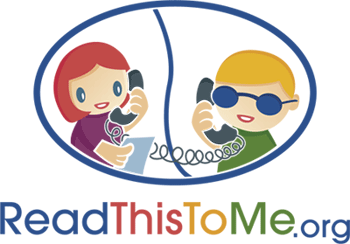
Read This To Me is a special program that allows the blind and people with vision impairment to have printed documents read to them over the phone.
It’s simple. Clients of the Read This To Me program fax documents (or anything else they need read aloud) directly to the program’s toll-free fax number, 877-333-8848. (Special instructions are provided to help clients ease difficulties with the faxing process.) The program’s clients will have already been set up to participate with cover pages including their first name and a callback (voice) phone number where they can be reached.
Clients can fax anything–legal documents, newspaper articles, handwritten notes, telephone bills, etc. The program then emails a PDF version of the faxed document to the volunteer reader, who then calls the client to read the document. The service is free to Read This To Me clients and available throughout the U.S. and Canada.
Volunteers need minimal training and need only meet a short list of requirements. To participate, you must:
- Reside in the United States
- Have access to a computer with a dependable Internet connection (Volunteers must have access to the internet while speaking with clients, so dial-up internet service is only acceptable if you have a second phone line, allowing you to be online and on the phone at the same time.)
- Have Adobe Acrobat Reader or any other PDF viewer installed
- Available time (five to ten minutes), several days each week, to place calls and read to clients.
- A willingness and ability to make long-distance calls. As clients of the service may be located anywhere in the U.S. or Canada, volunteers will be paying their own applicable long-distance service charges.
To volunteer, fill out this online form, and you will be contacted with further details.

A related program is Recording for the Blind or Dyslexic. Volunteers for this national non-profit organization visit regional recording centers to use special computers, software and recording devices to produce audio books on CD or via downloadable media for use by blind and dyslexic students.
While all willing readers are needed, especially for texts for Kindergarten through 12th grade levels, RFB&D offers opportunities for readers to record materials that match their professional and educational areas of interests, including accounting, computer science, finance, foreign languages, and science and technical subjects.
All volunteers are trained by RFB&D’s professional staff. Because this program involves complex readings in a variety of subjects, RFB&D’s directors participate in the recording sessions, helping operate the recording equipment and offering ad hoc assistance. Once each recording is complete, digital audio editors review the recordings to gauge quality standards. The finished recordings are added to RFB&D’s library of over half a million recorded texts. Last year, RFB&D volunteers’ work contributed to the ability of 237,298 students with visual impairments, learning disabilities or other special needs to gain access to recorded educational material.
If you think you might be interested in training to participate as a Reading For the Blind or Dyslexic volunteer, start with this link, or email volunteer@rfbd.org to receive further information.
BE A “REPORTER” TO KEEP THE MAIL RUNNING

ReportEZ is an intriguing volunteer program, run as part of a research project overseen by IBM, to help the post office improve efficiency and customer satisfaction. Yes, we all know the financial problems the U.S. Post Service has, are frustrated by the impending cancellation of one day of mail service, and hate paying increased postage costs. But that’s not what this is about. This program is designed not only to help the mail run on time, but to improve a huge service that is not merely national in scope, but which runs on literally every street and in every community in the country.
Over 17,000 volunteer “reporters” are needed nationwide to participate in the Transit-Time Measurement System. According to IBM, “the purpose this [System] is to measure the total time, from the date of mailing to the date of delivery, for many different types of mail.”
A volunteer reporter for either of the Transit-Time Measurement System panels simply needs to check his or her mail each day (for at least six months) and then notify (i.e., “report”) via phone or web as to when when certain pieces of mail are delivered. It takes only a few minutes per day and requires no special training (but does require strict confidentially, so be vewwwwy quiet hunting wabbits…I mean, keep your status as a mail reporter under your hat).
Volunteer reporters participate in either of two panels:
1)The External First-Class (EXFC) Panel, which has been in operation for 19 years, focuses on First-Class mail. IBM sends test mail to volunteers to determine how quickly and accurately mail arrives at its expected destination. The test mail is designed to look like any other generic piece of mail so as not to arouse the suspicion of USPS staffers, just as food critics do not identify themselves to restaurant servers as reviewers, but behave as typical patrons. And yes, I’m sorry I couldn’t find any volunteer opportunities for those who wanted to test the accuracy of restaurant menu descriptions!
As a volunteer on the EXFC panel, you’ll need to open your mail on a daily basis. For those of you, like Paper Doll, who love getting mail, this is just neato-keen. For those who have a tendency to let mail pile up, the responsibility of your volunteer position might be just what you need to get in the habit of examining your mail every day. Test mail is only identifiable as such once you’ve opened the envelope and find IBM’s test mail insert inside. The insert provides directions as to exactly how to report the date the test mail was received, which you’ll be able to do via phone or internet.
2)The new (since 2008) Scanner Panel has allowed the program to measure delivery speed and accuracy for mail types other than First Class. It requires somewhat more effort than the EXFC panel.
As a volunteer, you’ll be sent a special USB handheld scanner (similar the kind you might have used to add inventory to a wedding or baby shower registry) to plug into your computer. Then, you will not only scan the barcodes on any test mail you receive, but also any personal mail you receive with an Intelligent Mail barcode on it. That’s the barcode you probably already see on mail you get from various businesses–look for little barcode lines appearing just above your name and address. It operates like a tracking number to tell the sender whether the mail is still en route, or if it has reached a final destination.
As if the warm fuzzy you get from volunteering weren’t enough, mail “reporter” volunteers are rewarded for their time. Members of the EXFC panel occasionally receive gifts of postage stamps, and Scanner Panel members earn points which can be redeemed at various online merchants through the program’s web site, similar to miles/points earned by using your credit cards.
So, if you watched Mr. Rogers’ Neighborhood because you harbored a serious crush on Mr. McFeely  , or even if you just like the idea of helping the U.S. Postal Service run a little more smoothly, volunteer by going to this ReportEZ page, clicking on the Enter As A Referral button and following instructions to confirm interest and eligibility.
, or even if you just like the idea of helping the U.S. Postal Service run a little more smoothly, volunteer by going to this ReportEZ page, clicking on the Enter As A Referral button and following instructions to confirm interest and eligibility.
I don’t know anything about Sherry Anderson, author of the quote at the top of today’s post, but I believe she’s right. Readers, if and when you can volunteer–however…wherever…whenever…whatever, please do. Your help is priceless.
Show a Little Loyalty: Organizing Your Rewards and Loyalty Cards
~ Janet Robinson, CEO, The New York Times Company
Loyalty cards. It’s really a misnomer, because most people have multiple cards to numerous competing grocery, office supply, book, electronics and home remodeling stores. The stores hope that by providing you with a card that offers a discount on your purchase or points towards an eventual gift certificate, you’ll be more loyal to that store. Yeah, right.
In actuality, many of us sign up for rewards cards for any and all of the stores we frequent, planning to use whatever store has the best price for the item we need (or is the closest to wherever we happen to be driving when we recall that we need something). We are not necessarily loyal to the stores (nor they to us), but we simply wish to have the option of getting the discount in case we decide to shop there. That’s OK. There’s nothing ignoble about being a “summer soldier and sunshine patriot” in the war on economic unpredictability. (I’m sure Thomas Paine would understand our lack of loyalty in the face of economic times that try men’s…and women’s…souls.)
The problem? We’re drowning in loyalty cards (and their kid siblings, the keychain cards). We’ve talked previously about the ever-expanding George Costanza wallets, close to bursting with loyalty cards, frequent-flyer cards and all sorts of items not used on a regular basis. And Paper Doll has seen more than a few keychains with perhaps only one house and one car key, but so many Bed, Bath and Beyond-esque keychain cards that the car ignition practically groans under the weight.
The solutions to the overabundance of loyalty cards range from simple diligence to low-tech gadgets to using technology to avoid the cards altogether.
Just Say No–Many consumers opt to just saying no…not to the loyalty accounts, but to carrying any of the cards with them. At the vast majority of stores, you can provide your phone number and the cashier will do a manual look-up of your loyalty account number. While often satisfying, there are three drawbacks to this solution:
- Do you really want the creepy guy behind you in line to hear your phone number?
- More and more supermarkets and home remodeling centers have added self-checkout lanes. Which is more annoying, having to bring your loyalty card to the store or having stand in a long line because you need the cashier to look up your number?
- Not all cashiers are willing to do manual look-ups, either because their data access system is not two-way or because there’s a lengthy line behind you and today’s the day after Thanksgiving and why the heck do you have to complicate things for everyone else?!!!!
Reward true loyalty, yours and theirs, by dividing up the cards you use at least two to three times a month and keeping only those on your key ring or in your wallet. Keep the rest in a dollar-store credit card case, business card case or even a zip-lock baggie. My favorite suggestion comes from a reader at Life Clever, suggesting punching a hole in the corner of each card and using a carabiner-style clip:
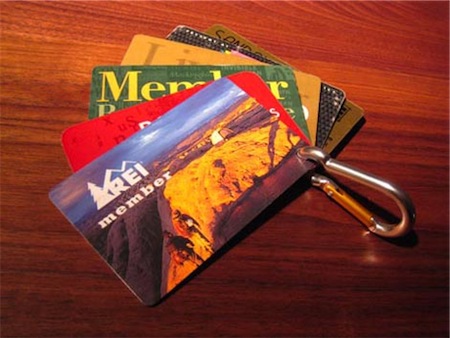
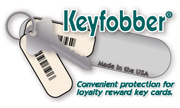
Keyfobber allows up to 10 cards to nestle together in a tray within the plastic shell. When you press the button, enabling the tray to slide out, you can access the cards to select the correct one for the cashier to scan, or pry open the key ring to add or remove cards. 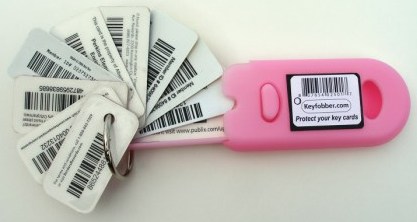
While I can’t imagine this is difficult for any Paper Doll readers to conceptualize, there’s an explanatory YouTube video with overly dramatic music to demonstrate. (Keyfobbers are $3.99 each and come in black, grey and pink; you don’t even need a Keyfobber loyalty card to buy 3 and get one free, or five to get two free with no-charge shipping).
United We Shop–Instead of carrying the multiple cards or key fob danglers, there are a few alternatives that let you create your own alternative super-card, collecting the information from multiple cards for easier display.

Just One Club Card allows you to collect the data from up to eight cards. Simply:
- Gather your loyalty and rewards cards.
- On the main screen, enter the bar code numbers, and then select the store/company name from the drop-down menu. You can select four for the front and four for the reverse of the new card. (If you’d like them grouped so that all your grocery cards appear on the front of the ensuing “Just One Club Card” and all your bookstore or home remodeling cards appear on the reverse, it’s easy enough to accomplish your preferred arrangement.)
- Click the Create Card button. If you’ve mis-typed and added too many or too few numbers, Just One Club Card recognizes and prompts you with a warning, telling you, for example, that the card you’ve entered usually has “11 or 12” or “20” or however many digits is usual. Simply check and revise your number, and click the Create Card button again. A sample (with fake account numbers, arrived at with the help of the number of digit warnings) appears below:
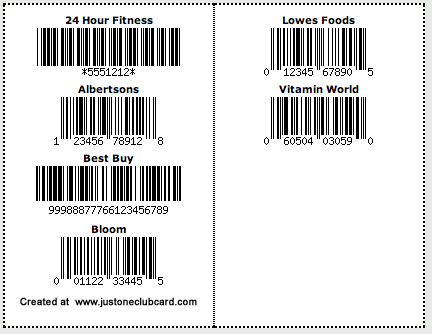
- On the ensuing screen, you’ll get a printable version of your card. Print it out, fold at the center and tuck it away in your wallet or planner. To add to its durability, the delightfully low-tech instructions advise you to use “magic tape” or laminate the card (which can be done inexpensively at any major office supply store).
The Just One Club Card is free (though you’ll have to suffer the annoyance of multiple Google ads cluttering the screen). You don’t need to provide any personal identifying information (not even an email address), and the system offers a special bookmarkable link so you can return and make revisions at a later time; don’t just bookmark the current work-screen, but click where it says “Bookmark or Link to this card”.
If you like the concept but find the end display just a little too shabby for your oh-so-chic level of loyalty, Just One Club Card has partnered with KeyRingThing to help you upgrade.
Unlike Just One Club Card, ![]() does require you to register, but the only personal information you provide is your name, email address and a password you create for the purpose of using the service. Then merely enter up to six company/store names (type them yourself or select from the drop-down options) and the associated bar code number.
does require you to register, but the only personal information you provide is your name, email address and a password you create for the purpose of using the service. Then merely enter up to six company/store names (type them yourself or select from the drop-down options) and the associated bar code number.
Once you’ve typed all your numbers, click “Preview Your KeyRingThing”. The system can be a little persnickety if you’ve hit

or you can order a double-sided, film-varnished, credit-card-sized, PVC version of your card for $4.97.
Finally, there’s a high-tech discount option that lets you skip loyalty cards altogether.
Wow Yourself With Yowza

Last year, three entrepreneurially-spirited guys on Twitter got together to create a nifty iPhone application called Yowza to help consumers save money. At first, the most interesting aspect of the project was that one of the founders was Greg Grunberg
 of Heroes, Alias and Felicity fame (who seems to be having at least as much of a ball with Yowza as he does with his acting career). However, as word and use of the “app”
of Heroes, Alias and Felicity fame (who seems to be having at least as much of a ball with Yowza as he does with his acting career). However, as word and use of the “app”It’s a free application, so if you have an iPhone or a iPod Touch, you can simply download the program from the iTunes store. Once it’s loaded onto your device, it works its magic to detect your exact geographic location (but not in a creepy way) and identifies money-saving deals within a 15-mile radius.
A wide variety of stores (including Pier 1, Saks Fifth Avenue, Sears and The Container Store) and restaurants (like California Pizza Kitchen and Rubio’s Fresh Mexican Grill) have negotiated specials deals for Yowza users; rather than generic repository or coupon aggregator, these are deals just for those vendors and consumers who are (you knew I was going to say it) loyal to Yowza! The cashier can scan the discount code directly off your device without you ever having to relinquish it, and there’s nothing extra to carry or hook onto your key ring.
Yowza works in the background, so you won’t get text messages or spam bugging you about new discounts; however, you can opt-in to be notified if/when a particular vendor has made a discount available. The app even keeps track of how much you save over time by using Yowza.
It’s not perfect. Yowza is new, so if you live outside of major cities, the number of discounts will be fewer. The service is only available in the United States, though they are working with merchants in Canada and elsewhere to make it more widespread. And at least for now, only iPhone and iPod Touch users, and not the mass of Blackberry and Palm and all those other fancy-schmancy smart phone users out there, have access to Yowza discounts.
Still, Yowza is growing and adding features all the time…and it’s free. So, even if you aren’t ready to throw away those loyalty cards just yet, this is an option to watch. Given apps like Yowza and the fact that consumers in Japan and elsewhere can make purchases (even from vending machines) and get discounts using their cell phones and RFID technology, Paper Doll imagines that high tech coupons and discounts are the wave of the future, and we’ll soon all be shedding our loyalties to loyalty cards.
Finally, as we inch closer to the two-year anniversary of Paper Doll, I hope this space serves as a weekly Hallmark card of loyalty to you readers. Thank you, as always, for reading.




Follow Me